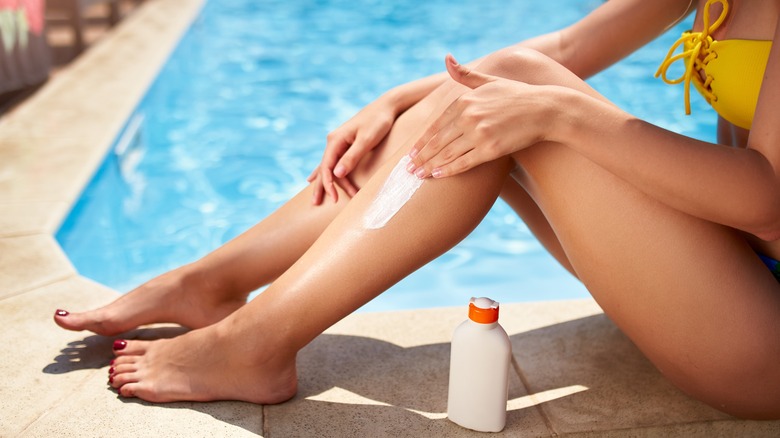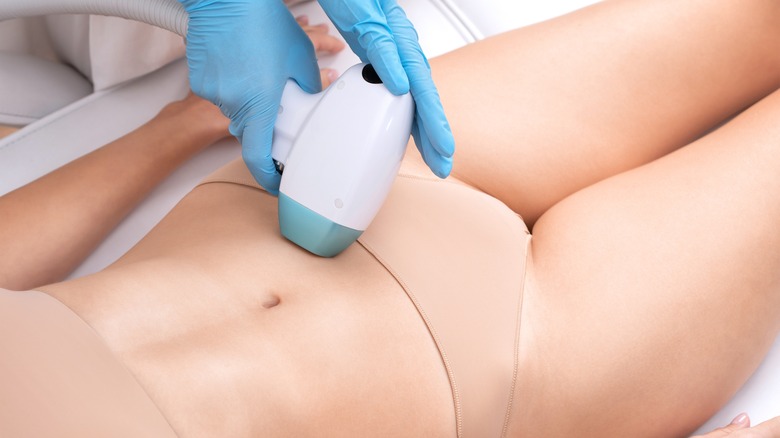How To Reduce Dark Skin Spots After A Wax
With bikini season quickly approaching, beach-goers are scheduling their waxing appointments while simultaneously booking their summer getaways. Waxing, as a form of hair removal, popped up in the 1960s, and since then it's become one of the top ways to remove hair. It can be done at home or at an office with a spa professional. Both are proven to rid yourself of unwanted hair almost instantly.
However, there are some dark sides to getting waxed, and the darkest of all are dark spots. Dark spots caused by waxing, also known as post-inflammatory pigmentation, are common and can happen to all skin types, but sensitive-skinned people are at greater risk. In this case, the dark spots after a wax are caused by inflammation. Ripping hairs out, along with dead skin cells, with hot wax is not a gentle treatment for your skin to undergo. Hyperpigmentation is your skin's reaction to this treatment. In other cases, dark spots can be caused by hormones and sun exposure.
Whether it's a leg, underarm, or bikini wax you're planning to get, it's always smart to prep your skin before you go in order to prevent irritation and dark spots and to maintain your wax for longer.
Preventing dark spots
Although post-inflammatory hyperpigmentation is always a risk when it comes to getting a wax, there are ways to help prevent it from happening. Much like a spray tan, exfoliation before an appointment is vital to getting the most out of your wax with the least amount of side effects. Proper exfoliation will clear away dead skin cells and make your skin smoother so it's better prepared for hair removal.
When waxing, opt for cool wax, which is available at home and in many spa locations. Cool wax is a better option for sensitive skin because it won't burn the skin or heat it up, making it more inflamed. Cold wax may have to be used multiple times for pesky hairs as it doesn't have as strong of a hold as hot wax.
In regards to aftercare, as well as preventative, it's important to use SPF when you're exposed to the sun. Finding a quality SPF for daily use is key. If you don't know where to look, ask your doctor or do a search for products recommended by dermatologists. And if you're suffering from dark spots no matter what you try, there are natural and gentle home remedies for dark spots, as well as brightening products available in a variety of price ranges. These products usually have vitamin C or alpha arbutin. Both of these ingredients help to stop the overproduction of melanin, which is the body's natural stress response to inflammatory experiences such as waxing.
Other hair treatments
If you're sick of dealing with post-inflammatory pigmentation due to waxes, there are other options that may be a better fit for your skin. One of the most popular methods right now, especially for people with dark hair, is laser hair removal treatment. This minimally painful treatment works by targeting the hair follicles that produce hair. One thing to note is that this doesn't instantly remove hair. Because it targets future hair growth, it takes several sessions to rid yourself of the hair. After that, most people do not see new hair growth for months and in some cases, years.
Shaving may seem barbaric if you're used to the luxury of a wax, but it's still a solid option when you're looking for instant gratification. To avoid dark spots with this method of hair removal, be sure to use a generous amount of shaving cream or product and always keep your razor wet. Don't be afraid to reapply the product as it will help to keep your skin smooth and prevent irritation due to shaving.


